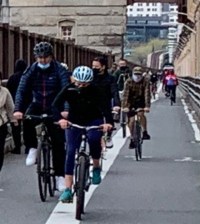EXCUSES, EXCUSES: DOT Offers Entirely New Rationale for Not Making 59th St. Bridge Safe for Peds, Cyclists

The city can’t create more space for cyclists and pedestrians on the Queensboro Bridge because the outer lane of the roadway is not safe enough for people on foot who might fall or jump over a low fence, but it is safe enough for high-speed automobiles.
That’s the new excuse offered by DOT Commissioner Polly Trottenberg when asked about longstanding demands to convert the bridge’s southernmost car lane, also known as the south outer roadway, into a pedestrian path so that bicyclists and pedestrians no longer have to share the narrow north outer roadway — a years-long problem that is particularly crucial during the coronavirus pandemic.
Up to this point, DOT has said it could not create more space on the bridge because an upcoming repair project to replace the upper deck of the bridge isn’t expected to be completed until 2022, and will require additional car capacity elsewhere on the bridge while that work is being done.
But this week, Trottenberg created an entirely new hurdle: the existing barrier on the outer roadway meant to prevent cars from driving off the bridge is too short to protect bikers and walkers.
“It’s really low and quite scalable, it’s not really safe unfortunately to use for bikes or pedestrians,” she said last week about a fence that is approximately six feet tall.

And simply putting up a temporary, more protective, barrier would be a “challenge” because the bridge is so long, said Trottenberg.
But Bike New York’s Jon Orcutt, who was a top DOT official during the Bloomberg administration, said the south outer roadway was used by bikers and pedestrians back in the 1980s and ’90s, and if it was safe enough then, it should be now.
“It’s a judgment call to be made — is there more to be gained when opening the lane now when there’s very little car traffic and lots of crowding on the north outer roadway?” he said. “Standards for those lanes have changed, but I don’t think people are hurling bricks or themselves off of the lane right now.”
The Triboro Bridge has a famously low wall on its pedestrian pathway. It barely rises to hip level:

If DOT wanted to, it could put up a temporary fence to encourage more socially responsible walking and biking during the virus crisis, a time when thinking outside the box is critical, said Orcutt.

“In DOT terms, it’s a very small undertaking versus other work. It’s a new time and we need to take some new steps. Let’s approach the situation as we face it today — we’re sort of in a pop-up world. We want pop-up bike lanes, open streets with sawhorses. It’s a tactical urbanism world and let’s approach things that way,” he said.
Queens Council Member Costa Constantinides, who last month demanded that DOT reallocate the south outer roadway to pedestrians, told Streetsblog on Tuesday that the city must take immediate steps to address the dangerous crowding on the bridge.
“If this pandemic has taught us anything, it’s that we can and should adjust to a crisis to keep New Yorkers safe,” said Constantinides. “DOT should at least explore temporary protective measures if it hasn’t already, because the current situation for pedestrians and cyclists presents its own public health risks. This is the time for innovation to make New Yorkers safer, including when it comes to our streets.”
DOT did not respond to additional requests for information.





